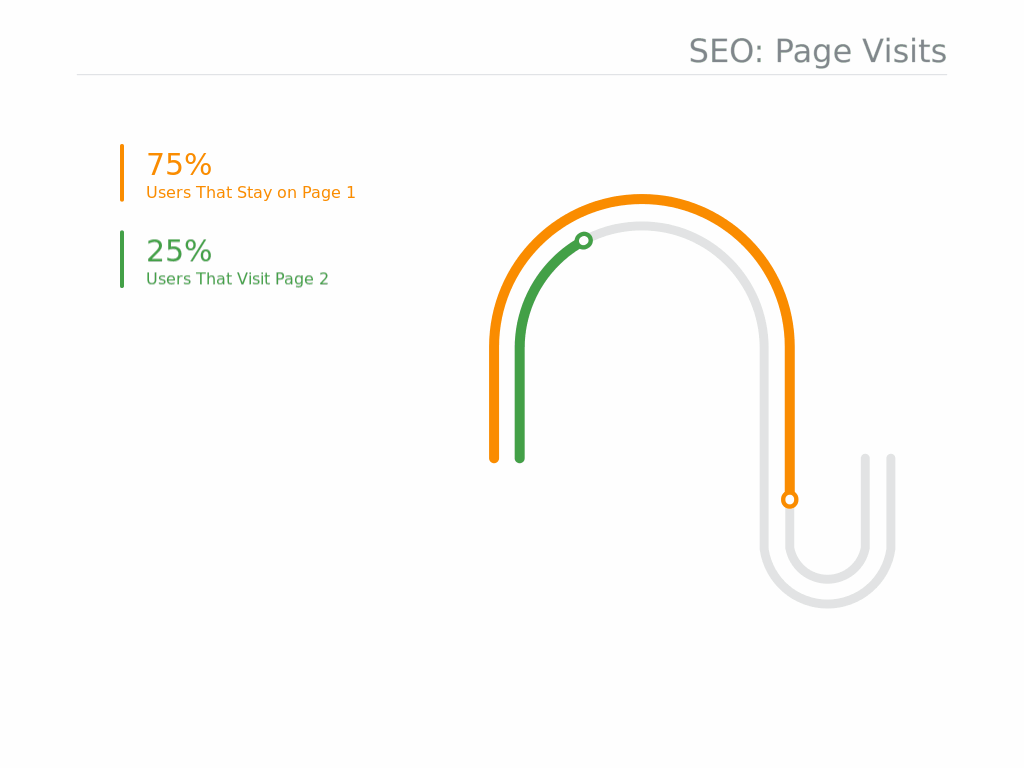-
 11 min. read
11 min. read
-
 Sarah Berry
Sarah Berry Lead Web Marketing Consultant
Lead Web Marketing Consultant
- Sarah Berry is a Lead Web Marketing Consultant at WebFX. With more than 10,000 hours of experience, she offers practical insights and strategies you can use to grow your digital revenue. When she isn’t polishing her Time Magazine Person of the Year Award, she’s spending time with her flock of ducks.
A spiffy, brand-new website — it’s exciting, right? Unfortunately, for many companies investing in a website redesign, that excitement turns to confusion post-launch. Your site, while eye-catching, isn’t bringing in traffic, leads, or sales because of a critical factor missing from your redesigned website: Search engine optimization (SEO). No matter your industry, audience, product, or service, SEO is a vital element of a website redesign.
Now, you probably have a few different questions, and this post is here to answer them, including:
- How does a website redesign affect SEO?
- Why do SEO with a website redesign?
- How do I redesign my website with SEO?
Keep reading to get started — and get your free website redesign SEO checklist! If you’re looking for a company that specializes in SEO and website redesign, WebFX can help. We’ve designed more than 1,058 sites, plus helped our clients earn more than $10 billion in revenue with strategies like SEO.
Contact us online or give us a ring at 888-601-5359!
Does a website redesign affect SEO?
Yes. SEO can affect a website redesign in two ways. Excluding SEO from a site redesign can cause a loss of both traffic and sales.
Including SEO in a website redesign, however, can result in traffic and sales increases. Since SEO optimizes your site for both people and search engines, it helps future customers find you through Google, Bing, and other search engines. You can launch one of the most well-designed sites in the world, but if you don’t optimize it for SEO, no one will find it.
That’s why SEO is essential for website redesigns.
If you don’t include search engine optimization in your redesign, that will hurt your SEO. 
Why does damaging my SEO matter?
Damaging your website’s SEO can lead to lower rankings in search results because your site will appear to have zero value from the perspective of search engines — and often users. That drop in rankings will impact your website traffic, lead generation efforts, and online sales.
For perspective on why rankings in search results matter so much, check out these statistics:
- 75% of users stick to the first page of search results
- 75% of all clicks go to the top three search results
- 33% of all clicks go to the first search result
While you can still bring traffic and customers to your website via paid advertising, this strategy requires a larger investment from your team. You’ll need a monthly ad spend for your paid ads, for example. Other approaches, like email and social media, also require an investment.
If you do include search engine optimization in your redesign, however, that can improve your SEO.
Improving your SEO can help your website increase its rankings in search results. In some cases, your site may even start appearing in more search results, which gives you additional visibility and the chance to reach more shoppers and business buyers in your target audience. These increases all translate to more website traffic, leads, and sales for your business.
Why do SEO with a website redesign?
You know that incorporating SEO into your website redesign can help your company increase its website traffic, as well as lead and sales numbers, but why else should you adopt SEO?
Whether your current site uses (or doesn’t use) SEO, you want to make it a part of your redesign for these reasons:
4 reasons to do SEO with a website redesign
- Receive a return on your redesign
- Get SEO built-in to your design
- Preserve any existing optimizations
- Create a launchpad for success
1. Receive a return on your redesign Web design pricing can cost anywhere from $1000 to $100,000. For that price range, you want a site that will perform and deliver a return on investment (ROI). Launching a redesigned website with SEO will help your business earn back its investment — and then some. That’s because your optimizations, like informational page titles or fast page speeds, will make your website more friendly to search engines and users.
For the best ROI, you will need to invest in optimizations that go beyond your website and encompass off-page SEO, like outreach. If you want a long-term ROI from SEO, you’ll need to make it a part of your ongoing marketing strategy. With ongoing optimizations, you can continue to earn top rankings in search results, as well as expand your presence across search results to help your company get seen by more of your target market.
2. Get SEO built-in to your design A new, redesigned site provides your company with a fresh start. It also offers you the chance to design and build a website optimized for SEO on the frontend and backend. These types of optimizations can include your page speed, navigation, internal linking, breadcrumb navigation, and more.
 Essentially, you get to build a website that users and search engines will love. Keep in mind that a website optimized for SEO doesn’t mean a boring website design. If you work with an agency that specializes in website SEO redesign, like WebFX, you can count on receiving an attractive yet SEO-friendly site — check out our portfolio for some examples.
Essentially, you get to build a website that users and search engines will love. Keep in mind that a website optimized for SEO doesn’t mean a boring website design. If you work with an agency that specializes in website SEO redesign, like WebFX, you can count on receiving an attractive yet SEO-friendly site — check out our portfolio for some examples.
3. Preserve any existing optimizations Companies that already use SEO can’t afford to exclude SEO from their website redesign. A redesign that forgets all about SEO, like by launching your redesigned site without any redirects, can cost your business a significant amount of money in lost traffic, leads, and sales. That’s why your internal team or web design agency must incorporate SEO into your redesign.
If you’re partnering with a web design company, make sure they understand search engine optimization and its impact on your site’s design and performance. Many agencies specialize in designing and developing websites and won’t include SEO. That means your business could lose all its hard work (and rankings) upon launching your new site.
4. Create a launchpad for success If you’re like most companies, you’re redesigning your website to help your business grow. You’re not looking to launch a new site to decimate your website traffic, online sales, or lead generation efforts, which can happen when SEO isn’t a part of your redesign. Instead, you want to update your site to make it easier for people to visit your website, purchase your products, or contact your team.
“Incorporating SEO in your redesign helps gear your site for success.”
Incorporating SEO in your redesign helps gear your site for success.
That’s why our agency, for example, doesn’t provide website redesign services without SEO. We want our clients to succeed and reach their goals for growing their companies. That’s why we incorporate and require SEO for all our redesigns because it sets your website up for success.
If you’re curious about the costs associated with a redesign, explore our website redesign pricing to find an option that fits your needs and budget.
Your free website redesign SEO checklist
Ok, are you ready to learn what goes into a website SEO redesign? Get started with our free website redesign SEO checklist:
1. Establish the sitemap and information architecture
 Before your web design agency or internal team begins creating your prototypes, you need to compile your current site pages and content. Using this existing content, as well as your plans for new content, you can build your redesigned site’s sitemap and information architecture. For example, as a part of your redesign, you may update your information architecture to reduce the size of your website’s navigation.
Before your web design agency or internal team begins creating your prototypes, you need to compile your current site pages and content. Using this existing content, as well as your plans for new content, you can build your redesigned site’s sitemap and information architecture. For example, as a part of your redesign, you may update your information architecture to reduce the size of your website’s navigation.
For instance, an ecommerce site may decide to create the following information architecture for its product listings:
- /products/womens/shirts
- /products/womens/blouses
- /products/womens/sweaters
This architecture helps the company organize its site and content better. It also creates a better browsing experience for users. A shopper looking for women’s sweaters, for instance, can find this product section faster.
Once you establish your information architecture, you can outline your sitemap. A sitemap helps search engines and users understand and navigate your website. Usually, sitemaps will feature links to core pages on your site, like your service or product category pages.
Sitemaps should not have more than 100 links. Depending on your design, your custom 404 page may feature your sitemap.
2. Compile on-page optimizations
Next, your design, development, and SEO team will want to audit your existing content. If you’ve been using SEO, you’ll have optimized this content for search engine optimization. The content may target specific keywords, for example, or include links from trusted websites in your industry.
You’ll want to compile all this information in an easy-to-access document, like a Google Sheet.
“While compiling and auditing your current content, look for optimization opportunities.”
Based on your optimizations, as well as revised information architecture, you can determine the location of pages in your website’s new information architecture. If you have an in-depth guide, for instance, you may place it in the /guides/ section of your site versus your /blog/. While compiling and auditing your current content, look for optimization opportunities — you can even use a website optimization checklist to guide you.
If you have images without alt text, for example, you could make it a part of your redesign to add image alt text. Should you partner with a web design and SEO agency, like WebFX, you can trust your WebFX team to handle this step.
3. Map every 301 redirect
Redirects are a critical part of website SEO redesigns. That’s because a redirect, also called a 301 redirect, tells search engines where to find relocated content. If you launch your website with a new domain name, for instance, you’d have redirects that would tell search engines about the new location of your site.
Even if you don’t launch your redesigned site with a new domain name, you will likely use 301 redirects if updating your website’s information architecture. For example, you may move the page “/winter-landscaping-services” to “/services/winter-landscaping-services/” with a redirect. As redirects can become intensive and overwhelming, especially for large sites, you want to create a document that maps your planned redirects.
Use Google Sheets, for example. This document can prevent mistakes and ensure you use the current URLs for redirecting content.
4. Create site backups
Backups are another essential component of website redesigns and SEO. If you should need to restore your previous site, like in the case of forgetting to redirect a page, you can return to your backup. While you can back up your site to a computer or laptop, you can also set up a temporary server to host your website.
Once you store a backup of your site, you can move forward with launching your brand-new website.
5. Submit XML sitemap
Following your website’s launch, you want to make sure search engines know about it. You can submit your site URL to Google a few ways, including via an XML sitemap. For many businesses, an XML sitemap offers the fastest and easiest solution because it instructs a search engine to crawl your entire site. If you like, however, you can submit each URL manually via Google Search Console.
 After this step, you want to monitor your organic traffic and rankings. Depending on your redesign, you may see a temporary drop in rankings and traffic, like if you move your site to a brand-new domain. In addition to traffic and rankings, you want to watch for broken links (or 404s), as well as crawl errors.
After this step, you want to monitor your organic traffic and rankings. Depending on your redesign, you may see a temporary drop in rankings and traffic, like if you move your site to a brand-new domain. In addition to traffic and rankings, you want to watch for broken links (or 404s), as well as crawl errors.
If you partner with a web design and SEO agency, like WebFX, we’ll take care of this process for you.
Make your website redesign and SEO a breeze with WebFX
A website redesign with SEO requires a vast skill set, from design to development to SEO. For many companies, that’s a challenge. At WebFX, however, we make it easy.
That’s because we feature a talented team of 500-plus professionals, from designers to developers to SEOs. Not to mention, we’ve launched more than 1,058 sites and won more than 155 web design awards. Launch a website that your team and target market love by partnering with WebFX.
Contact us online or call us at 888-601-5359 for a free quote today. Or, use our free website cost calculator to get an instant estimate for your website redesign and SEO — no contact information required.
-
 Sarah Berry is a Lead Web Marketing Consultant at WebFX. With more than 10,000 hours of experience, she offers practical insights and strategies you can use to grow your digital revenue. When she isn’t polishing her Time Magazine Person of the Year Award, she’s spending time with her flock of ducks.
Sarah Berry is a Lead Web Marketing Consultant at WebFX. With more than 10,000 hours of experience, she offers practical insights and strategies you can use to grow your digital revenue. When she isn’t polishing her Time Magazine Person of the Year Award, she’s spending time with her flock of ducks. -

WebFX is a full-service marketing agency with 1,100+ client reviews and a 4.9-star rating on Clutch! Find out how our expert team and revenue-accelerating tech can drive results for you! Learn more
Try our free Marketing Calculator
Craft a tailored online marketing strategy! Utilize our free Internet marketing calculator for a custom plan based on your location, reach, timeframe, and budget.
Plan Your Marketing Budget

Proven Marketing Strategies

Proven Marketing Strategies
Try our free Marketing Calculator
Craft a tailored online marketing strategy! Utilize our free Internet marketing calculator for a custom plan based on your location, reach, timeframe, and budget.
Plan Your Marketing Budget
What to read next





